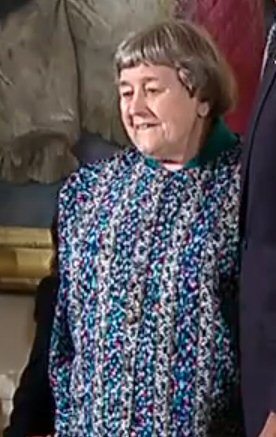Yvonne Brill facts for kids
Quick facts for kids
Yvonne Brill
|
|
|---|---|

Brill in 2011
|
|
| Born |
Yvonne Madalaine Claeys
December 30, 1924 |
| Died | March 27, 2013 (aged 88) |
| Nationality | Canadian/American |
| Alma mater | University of Manitoba, University of Southern California |
| Occupation | Aerospace Engineer Rocket Scientist |
| Awards | AIAA Wyld Propulsion Award (2002) John Fritz Medal (2009) Inducted into the National Inventors Hall of Fame (2010) National Medal of Technology (2010) |
Yvonne Madelaine Brill (born Claeys; December 30, 1924 – March 27, 2013) was a Canadian-American engineer. She was an expert in rocket and jet propulsion. Yvonne Brill invented a special rocket engine that helps satellites stay in orbit. This invention made satellites much more fuel-efficient. Throughout her career, she worked on many important space programs in the United States, including those for NASA.
Contents
Early Life and Education
Yvonne Brill was born in Winnipeg, Manitoba, Canada. Her parents came from Belgium. When she was in high school, a teacher told her that women couldn't succeed in science. Her father also wanted her to stay home. But Yvonne didn't listen to them.
She went to the University of Manitoba. At that time, women were not allowed to study engineering there. So, she chose to study chemistry and mathematics instead. She was a top student and earned her bachelor's degree in 1945. Later, she studied at the University of Southern California. She took night classes and received her master's degree in chemistry in 1951.
Yvonne Brill's Amazing Career
Yvonne Brill's work on satellite engines led to many important discoveries. She created a new type of rocket engine called the hydrazine resistojet. She suggested using just one type of fuel for it. This made the engine simpler and more effective.
Her invention made rocket engines perform better and more reliably. It also meant satellites needed less fuel. This allowed them to carry more equipment or stay in space for a longer time.
Working in Space Science
In the 1940s, Yvonne Brill was thought to be the only woman in the U.S. researching rocket science. In 1945, she was hired by Douglas Aircraft. She helped develop the first American satellites.
In the 1950s, she took a break from her career to raise her children. She returned to her field in 1966. She joined the Radio Corporation of America (RCA).
The Hydrazine Resistojet Invention
Yvonne Brill invented the hydrazine resistojet propulsion system in 1967. She even held a U.S. patent for it (No. 3,807,657). Her invention became a standard for the space industry. It helped commercial communication satellites earn millions of dollars more.
Brill also helped with the engines for several important space missions. These included TIROS, the first weather satellite. She also worked on Nova rockets, which were used for Moon missions. She contributed to Explorer 32, the first satellite to study the upper atmosphere. And she worked on the Mars Observer, a spacecraft that went to Mars in 1992.
Awards and Special Honors
Yvonne Brill received many awards for her important work.
- In 2002, she won the AIAA Wyld Propulsion Award.
- In 2009, she received the John Fritz Medal from the American Association of Engineering Societies.
- In 2010, she was honored by President Barack Obama with the National Medal of Technology and Innovation.
- Also in 2010, she was added to the National Inventors Hall of Fame.
- In 2001, she received the NASA Distinguished Public Service Medal.
She was chosen to be a member of the National Academy of Engineering in 1987. The American Institute of Aeronautics and Astronautics (AIAA) has a special lecture series named after her, called the Yvonne C. Brill Lectureship. For the last 20 years of her life, she worked to support women in science and engineering. She helped nominate them for awards they deserved.
Later Life and Legacy
Yvonne Brill lived in Skillman, New Jersey. She passed away in Princeton, New Jersey, on March 27, 2013.
After her death, an article about her was published in The New York Times. The first version of the article focused too much on her family life. Many people felt it didn't properly highlight her amazing scientific achievements. This led to a discussion about how important it is to recognize a person's professional accomplishments, especially for women in science. The newspaper later changed the article to focus more on her incredible career.
See also
 In Spanish: Yvonne Brill para niños
In Spanish: Yvonne Brill para niños

